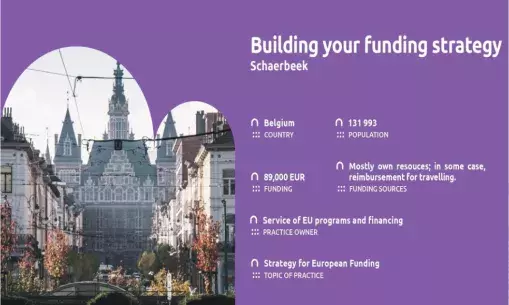Handbook of SUD strategies Chapter 5 - Funding and Finance

Introduction
Suitable funding and finance arrangements are a key pillar of Sustainable Urban Development (SUD) as promoted by the EU’s cohesion policy. There are two long-established trends in delivering this policy (Bachtler, Mendez and Wishlade, 2017; OECD, 2018): combining multiple funding sources and, on a related note, the increasing significance of ESIF financial instruments. In the case of cohesion policy, the term financial instrument means a mechanism which transforms EU resources into financial products such as loans, guarantees, equity etc. Financial instruments are foreseen in Article 37 of the Common Provisions Regulation.
The rationale behind the use of multiple funding sources is that this provides efficiency gains by exploiting synergies with European Structural and Investment Funds (ESIF), and that it mobilises a wider range of actors and resources. In this way, the added value of structural funding is optimised and cohesion policy’s capacity to steer and to accelerate investment is enhanced. When it comes to integrated Sustainable Urban Development (Article 7, Regulation (EU) No 1301/2013) in particular, an additional justification for combining funding sources is that integrated Sustainable Urban Development concerns itself with a diverse range of complex urban issues. Therefore, a range of funding sources have to be deployed in order to secure full funding for a programme whose scope is to address interrelated social, economic and environmental issues in a strategic and integrated manner.
The significance of ESIF as contributors to SUD strategies in the 2014-2020 programming period varied across member-states. According to data from STRAT-Board, 60% of the strategies committed more than € 5 million of EU funding per strategy, but utilisation of multiple ESIFs per strategy was not a widespread practice.
In lower income countries, the challenge was to complement EU funds with alternative sources of funding. In higher income countries, ESIF played a role in funding investment in a limited number of regions or target areas. There, SUD strategies were able to act as tools to coordinate an intervention and used ESIFs to complement other sources of funding (national, private etc.).
The financial support for SUD via integrated territorial development was proposed to increase from a minimum 5% to a minimum 8% of European Regional and Development Fund (ERDF) resources at national level in the 2021-2027 programming period. This, in itself, adds to the momentum favouring the combination of funding sources and the broader use of financial instruments. This trend is bound to be reinforced by thematic concentration of ERDF and Cohesion Fund (CF) resources on a well-defined yet diverse range of thematic areas as well as by low growth and increasing regional disparities in the post-crisis era.
Combining funding sources is not only a matter of doing more with less but also a matter of identifying the necessary resources and channelling them to projects that are best suited to address the policy issues at hand. For example, energy efficiency in buildings could be funded via grants, but because such projects have the potential to generate revenues or savings, it is in principle feasible to finance them via financial instruments, utilising revolving funds.
The policy-oriented structure of the diverse EU funding landscape could in principle incentivise prospective project promoters to prepare policy-relevant investment projects which they may otherwise have not considered worthwhile. ESIF financial instruments in particular, are mainly aimed at tackling market failure and sub-optimal or imperfect market operation (EIB, 2015; OECD, 2018). Therefore, by extension, local authorities (LAs) which have the capacity and know how to draw funding from a diverse range of funding sources could draft investment programmes which would be better placed to support the implementation of integrated sustainable urban development plans. In the 2021-2027 programming period, it is anticipated that cities will be able to use an updated version of their existing integrated urban development strategies to access the dedicated SUD funding support. This will mean that a coherent investment programme to back up said strategies will be even more important if cities are to combine funding sources in order to implement their existing strategies.
There are a few key challenges (OECD, 2018; Windisch, 2019) that have arisen during the current programming period in terms of funding and financing SUD. The first and arguably most important set of challenges has to do with the institutional and administrative capacity of local authorities (LAs), and to some extent managing authorities (MAs) too, to plan and manage SUD strategies. The requirement for an integrated approach was quite novel to many MAs and LAs across the EU and thus, understandably, significant familiarisation time was required. After the concepts were understood, adopted and made mainstream in the national context, it proved challenging for LAs to match the administrative requirements and target groups of various ESIF, domestic funds and financial instruments between them under the umbrella of an SUD strategy. These requirements can extend to anything from differences in eligibility rules, to the timing of the calls, to the quality of the SUD strategies, to the design of the OP itself (which exceeds LA competence).
The second set comprises challenges connected to the ability or willingness of las to take on debt, due to:
- political and legal factors as well as debt ceiling regulations
- the small size of the LA’s budget/revenue
- the small size of the projects the LA wishes to carry out
The third is the capacity of LAs to manage programmes which combine ESIF grants with products offered by financial instruments and other private and/or domestic sources, starting from the legal establishment of such programmes within the national legal and institutional context. In several national contexts, LAs’ competencies in dealing with issues pertaining to the provision of public and merit goods and associated services.
Negotiating with financial institutions and being able to understand, let alone design, financial strategies of this sort is more often than not something quite novel to LAs.
Finally, there are cases and contexts where a ‘grant’ culture has taken hold. Therefore, administrative and political personnel do not see a benefit in combining funding sources and using products offered via financial instruments as part of a comprehensive investment programme. Interestingly enough, when intermediate lending is used to overcome this difficulty (for example when the EIB lends to a National Promotional Bank which in turn provides credit to projects directly), then issues arise about the capacity of the intermediary to manage said projects in an adequate way.
This building block will therefore discuss three main themes:
- the integration of ESI funds amongst themselves and with domestic funds;
- the involvement of private investors and the third sector in funding SUD strategies;
- the use of financial instruments and financial products in SUD.
The first section will address how to better align ESIF amongst themselves and with other available domestic sources. Thus, this section will also discuss issues of strategy drafting and of stakeholder coordination.
The second section elaborates on how suitable bankable projects could be developed and institutional provisions and programme designs which could tackle policy and planning risks and thus facilitate engagement with private sector investors within the SUD framework.
The third section is closely related to the second and addresses the role of financial instruments and financial products within the SUD framework.
Part 1 : The integration of ESI funds amongst themselves and with other domestic funding
The regulatory provisions for SUD strategies promoted the idea of combining multiple funding sources, although this was not obligatory. The main rationale for this approach was operational effectiveness: integrated urban development tries to address a diverse set of interconnected issues while each funding stream, for example each structural fund, has different thematic priorities, different target groups (companies, people etc.), different conditions for awarding funding, specific monitoring, evaluation and financial reporting mechanisms. The same applies when it comes to domestic funding streams. It could be argued that the diversity of funding rules and priorities between funding sources works against the concept of co-funding. The same could be said about the EU state aid regulatory regime. In addition, in order to address a wide range of complex challenges it would be necessary to engage multiple stakeholders and, given the scale of the issues to be addressed, to provide a mix of public, private and merit goods. An SUD strategy could therefore be utilised as a vehicle for organising said funding sources in a coherent area-based intervention programme.
A wealth of information and insights regarding how ESI funds could be combined amongst themselves and with national funding regimes comes from the Urban Development Network (UDN) workshop outputs[1]. These indicate that a fit-for-purpose SUD strategy should be able to highlight the social, economic and environmental dimensions of the challenges facing the target area in order to identify appropriate EU funds. This, in turn, facilitates the coordinated use of ESI funds with domestic funds at the level of the SUD strategy. Coordination becomes easier in cases where national policies and strategies take into account EU thematic priorities and the national funding regime has consolidated its funding agencies and mechanisms.
Part 1 : The integration of ESI funds amongst themselves and with other domestic funding
Learn morePart 2 : Involving private investors and the third sector in sud funding strategies
An SUD strategy identifies needs and thus provides fertile ground to come up with project ideas on how to tackle those needs. In some cases, depending on the context in each country, some projects would be best suited to public funding but in other cases there may be scope for involving other actors in the funding process (citizens, third sector), for establishing public-private partnerships or for private investors to engage with their own ideas and funding.
The integrated planning approach inherent in SUD strategies can assist in identifying a wide range of challenges which are specific to an intervention area or may even be relevant to a wider area. When said challenges, which are often linked to negative externalities, are addressed, an area may well turn into an attractive destination for private investment. Very often, businesses and the real estate sector are attracted to such areas, which have benefitted from improved accessibility, environmental amenities and enhanced infrastructure and social welfare provision. Once an area is turned around in this way, the focus of public policy often shifts towards managing growth in that area.
An SUD strategy would usually be a precursor to such an area turnaround and the challenge during its drafting and implementation is to attract investors who would be willing to invest in projects in line with its objectives (as for example the transition to a low-carbon economy). Key to such engagement are projects that offer net revenue or a saving as well as a suitable risk-sharing protocol and therefore are potentially ‘bankable’[2]. Including such projects in an SUD strategy could widen its scope and diversify its funding sources.
By the same token, many of the investments carried out as part of an SUD strategy will provide much-needed public goods but will not generate revenue or savings. In fact, such investments in public goods may well require additional resources from the (public) agency/body which will be called upon to operate and manage them. Engaging the third sector and civic society may well provide a way for public authorities to diffuse the costs, multiply the benefits of said investment and enhance the local sense of ownership and pride of place by passing on the operation and maintenance responsibility to stakeholders who are willing to assume stewardship of said infrastructure.
Part 2 : Involving private investors and the third sector in sud funding strategies
Learn morePart 3 : Enhancing the use of financial instruments and financial products
There has been an established tradition of using financial instruments to deliver programme support[6] at least since 1994-1999[7], but their use at that time was focused on supporting enterprises in some Member States. Their use became more widespread in subsequent programming periods and as of 31 March 2017, ‘operational programme contributions paid to the Financial Engineering Instruments in the area of urban development […] amounted to € 1,595.59 million[8]’ whereas ‘the total amount committed in funding agreements to Financial Engineering Instruments from the 172 ERDF and 20 European Social Fund (ESF) operational programmes (OPs) […] was € 16,967.80 million[9]’. In the 2014-2020 programming period, financial instruments ‘represent more than 10% of ERDF resources’ with more than EUR 14 billion allocated to financial instruments by the end of 2017[10].
A significant turning point for the use of financial instruments was the introduction of the ‘Investment Plan for Europe’, which became known as ‘The Juncker Plan’ after Jean-Claude Juncker, the former president of the European Commission who announced it in November 2014. The European Fund for Strategic Investments, one of the three pillars of the ‘Investment Plan for Europe’ is estimated to have offered EUR 65 billion in guarantees from the EU budget to the European Investment Bank (EIB), in order to mobilise market-driven investment of over € 400 billion in higher-risk projects.
Crucially, although the European Fund for Strategic Investments is demand-driven, meaning there are no sectoral or geographic quotas, it has triggered the highest percentage of investment/GDP mostly in countries in Southern and Eastern Europe[11]. Although it is too early to assess the impact of the ‘Investment Plan for Europe’ in terms of territorial and social cohesion, it has indeed served as a proof of concept for the potential of financial instruments in leveraging resources and managing risk, and has enhanced the role of the EIB as an EU policy implementation agent. The ‘Investment Plan for Europe’, which has almost run its course, will be followed by the ‘InvestEU’ initiative[12] in 2021 (see box on InvestEU Programme).
Part 3 : Enhancing the use of financial instruments and financial products
Learn moreAbout this resource
The Joint Research Center – Territorial development unit supports the territorial articulation of the EU policy agenda, its external investment and global outreach. Our aim is to deliver world-class science-for-policy support to bring Europe closer to citizens and places, turning territorial diversity into value.
Similar content



